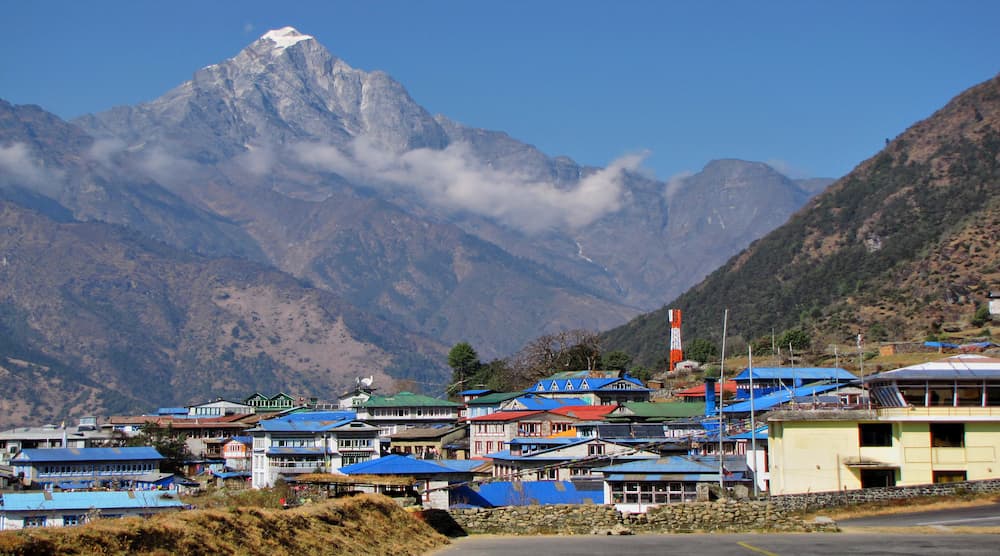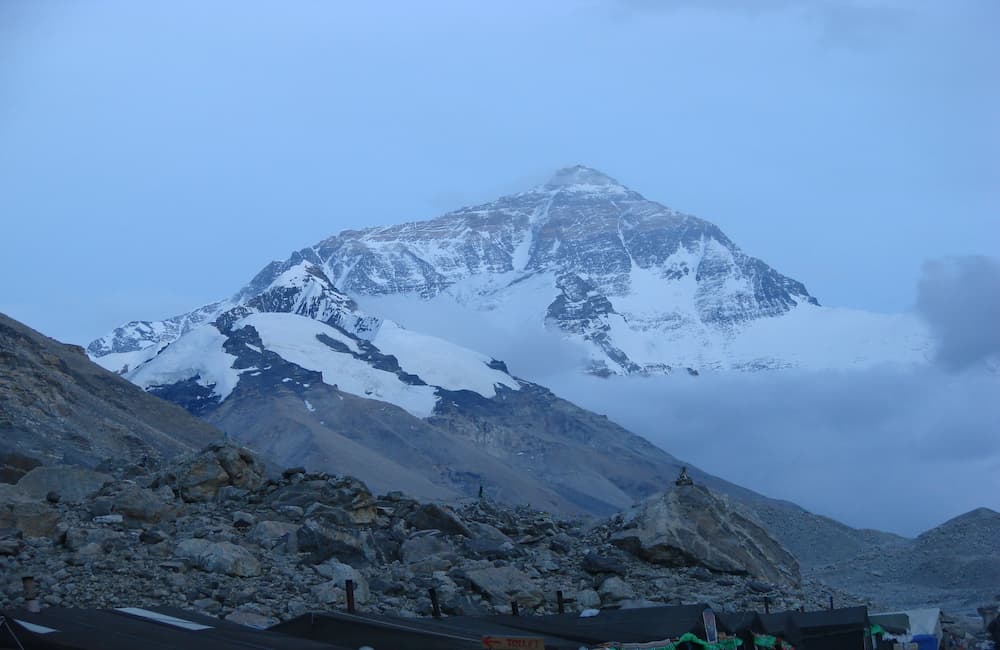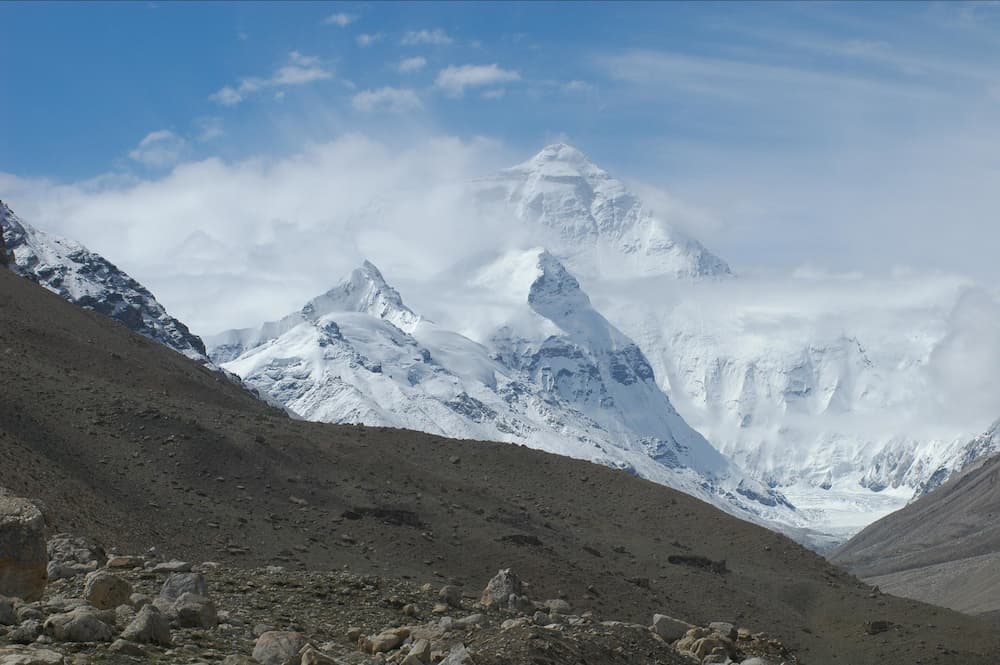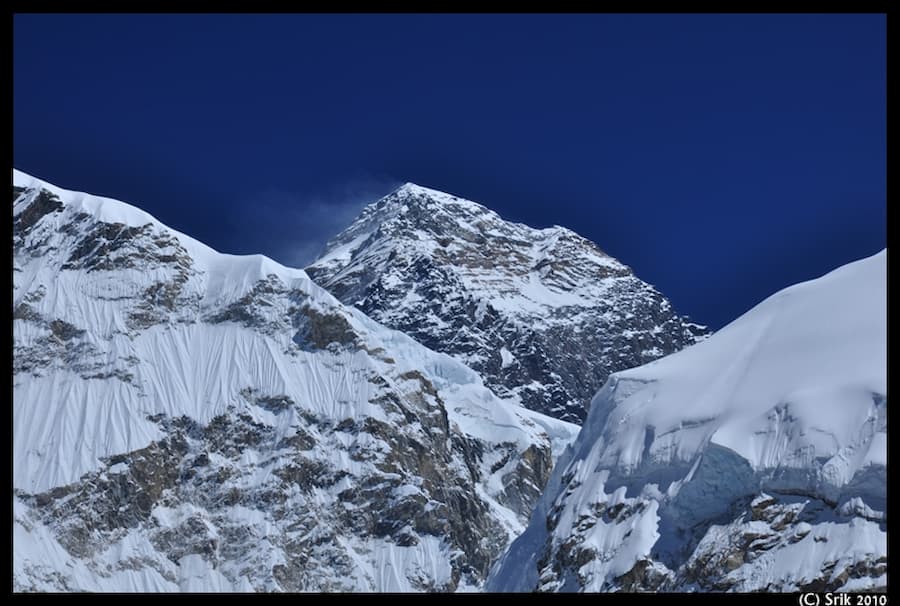The Elevation of Everest and Its Update
With its breathtaking height, Mount Everest, the gem in the Himalayas, has long captured the attention of people. Everest's elevation was reassessed after it was first recorded at 29,002 feet (8,848 meters) above sea level due to developments in technology.
Slightly below the previous measurement, a Chinese survey team measured the elevation in 2005 at 29,017 feet (8,844 meters). However, the biggest change occurred in 2020 when China and Nepal jointly declared a revised elevation of 29,032 feet (8,848.86 meters).
This modification, which accounts for the snow and ice covering the top, represents the teamwork involved in producing the most accurate portrayal of Everest's size.
.jpg)
Peaks in the Mountains Encircling Mount Everest
Towering over the Himalayan range, Mount Everest is surrounded by several other daunting peaks in an equally beautiful environment. Lhotse, the world's fourth tallest peak, is to the south of Everest and is connected to it by the South Col. Part of the Everest Massif, the formidable Makalu towers to the southeast.
When we turn to the west, the imposing Cho Oyu—the world's sixth-highest peak—graces the horizon.
The breathtaking scene that greets climbers on their difficult journey to Everest's summit is largely attributed to these surrounding giants, which together are known as the Everest Massif.
The ideal location to see Mount Everest
There is a special vantage point that offers views of Everest for those who choose not to make the difficult trek to the summit.
Located close to the Nepalese side of Everest Base Camp, Kala Patthar offers a broad view of the highest peak in the world. Situated at a height of 5,545 meters (18,192 feet), it is a well-liked trekking site that provides hikers and tourists with an incredible up-close view of Everest and the neighbouring peaks.
In addition to offering a breathtaking view of Mount Everest, the trip to Kala Patthar enables hikers to take in the untamed beauty of the Himalayan landscape. Prayer flags, rough paths, and the omnipresent silhouette of Mount Everest mark the route to this viewpoint.
.jpg)
Various Mount Everest Climbing Routes
Climbers facing the daunting task of ascending Mount Everest must choose from a variety of routes, each posing unique challenges. of challenges and benefits. The North Col Route, which is reachable from Tibet, and the South Col Route, which is reachable from Nepal, are the two main routes.
South Col Route
Climbers begin in Nepal and proceed to the South Col via the Khumbu Icefall, the Western Cwm, and an ascent of the Lhotse Face. The last push up the southeast ridge to the summit is made from the South Col. With the famous Base Camp located on the Nepalese side, this route is the more popular option.
Col Route North
To reach the Tibetan side, one must traverse the Rongbuk Glacier, make their way through the North Col, and then climb the North Face. After there, climbers travel across the Northeast Ridge to the summit. The North Col Route presents a distinct viewpoint and set of difficulties in comparison to its equivalent in the South.
The History of Mount Everest Climbing
The history of Mount Everest is entwined with the unwavering spirit of adventure and the quest for seemingly unachievable goals. The first successful climb on May 29, 1953, led by Tenzing Norgay, a Sherpa from Nepal, and Sir Edmund Hillary of New Zealand, is without a doubt the apex of this history. Every year on May 29, which is designated as Everest Day, people celebrate this victory and its significance.
Sherpa Tenzing Norgay and Sir Edmund Hillary
Sherpa Tenzing Norgay and Sir Edmund Hillary
Through the South Col Route, the two climbers accomplished this historic feat while enduring hazardous circumstances and harsh terrain.
Their victory left their names in the annals of climbing history, but it also made it possible for climbers of later generations to challenge the highest peak in the globe.
Everest has seen other ascents since then, each with its special difficulties and victories. The mountain is a symbol of the human spirit's tenacity and the never-ending quest to explore new territory.
Mount Everest was unclimbed when Sir Edmund Hillary and Tenzing Norgay made history, luring previous teams with their tremendous obstacles.
The British Mount Everest survey team led by Lieutenant Colonel Charles Howard-Bury in 1921 was one of the most notable of them. This expedition mapped the area and identified viable routes, laying a vital foundation even if reaching the top wasn't their main objective.
There were several attempts in the 1920s and 1930s, most notably the British expeditions of 1922 and 1924. Even though they encountered difficulties and tragic losses—such as the unexplained disappearance of Andrew Irvine and George Mallory in 1924—these early expeditions gave important insights into the harsh realities of Everest.
The historic 1953 ascent of Everest was made possible by these early phases of the expedition.
Nature and Flora of the Everest Area
In addition to being a refuge for mountaineers, the Everest region is home to a wide variety of plants and animals that have adapted to the harsh conditions of this high-altitude habitat. brilliant wildflowers, which contrast magnificently with the mountains covered with snow. Nature's tenacity is demonstrated by the resilient lichens and mosses that cling to rocks even at the highest elevations.
Numerous species of animals can be found in the Everest region, such as the red panda, Himalayan tahr, and the elusive snow leopard. Soaring across the mountainous skies are birds like the bar-headed geese and the Himalayan Monal, which is also Nepal's national bird. A reliable and robust friend, the yak plays a significant role in the cultural and economic life of the area

The Everest Region's Population
- The Everest region is more than just a natural wonder; the rich cultural strands of the people who live there are woven into a vivid tapestry.
- The Sherpas, well-known forAs you ascend, the scenery opens out to reveal alpine meadows decorated with
- The history and legend of Everest have been greatly influenced by their fortitude, tenacity, and knowledge of mountaineering.
- These mountainous tribes have cultivated a symbiotic relationship with the lofty peaks thanks to their customs and traditions.
- Particularly the Sherpas are vital to climbing expeditions that aim to reach the summit of Everest as guides, porters, and helpers.
- The Everest story is further enhanced by their enduring bond with the region and its spiritual importance.
Climate Change's Effect on Everest
The far-reaching consequences of climate change are also felt by the majestic, towering Mount Everest. The Himalayas, which includes Everest, are warming faster than the rest of the world, causing significant and obvious changes in the area.
A Geopolitical Context
Mount Everest is more than just a geographical feature; it holds much geopolitical significance. The mountain lies along the international border between Nepal and Tibet region of China; hence, it is an important point of interest for both countries.
Nepal Side: In Nepal, Mount Everest is known as "Sagarmatha," which means "Goddess of the Sky." The southern face of Everest including the famous south col route to the top, is part of Nepalese territory. Because access to base camps is easier, infrastructure is better developed, and there are already established mountaineering support services, Nepal has been the preferred starting point for many climbers.
Tibetan (Chinese) Side: In Tibet on the northern side, this mountain is called by its inhabitants ‘Chomolungma’ meaning ‘Goddess Mother of World’. The Chinese government controls entry into these areas hence they remain less frequented by climbers but offer an isolated quiet experience instead. The northern route up contains much harder conditions such as extreme weather and longer climbs.
Mount everest has an exceptional governance system that demands collaboration between Nepal and China over matters related to physical environment sustenance, tourist management practices and climber safety. It is important to undertake it for growth management of visitors’ influxes and sustainable ways of using its resources.

Historical Significance of Everest's Location
Mount Everest has been an important landmark throughout its history and in the development of mountaineering. The first survey of the mountain took place in 1856 by a British surveying team when it was referred to as Peak XV before getting its new name after Sir George Everest, Surveyor General of India at that time.
Early Exploration: The first serious attempts to climb Everest began in the 1920s, with expeditions approaching from the Tibetan side. These early efforts were marked by significant challenges, including difficult terrain, lack of proper equipment, and limited knowledge of high-altitude climbing.
Political Shifts: The geopolitical landscape shifts dramatically after World War II leading to changes in access to Everest. When Tibet was annexed by China in the 1950s access to the northern route became restricted. This political change made it possible for climbers to concentrate on the southern route through Nepal where they found an easier and friendlier ground for their activities.
The first successful climb: Sir Edmund Hillary and Tenzing Norgay made their successful ascent from Nepal along the southern route that later became known as their way. This was a historical moment which not only made the mountain world famous but also marked the importance of Nepal in the history of climbing Mount Everest.
Everest’s Place in the Himalayan Mountain Range
Mount Everest is situated in Mahalangur Range, one of the subranges in the Himalayas, which are home to four out of the six highest peaks globally: Everest,Lhotse, Makalu and Cho Oyu. The Himalayas themselves were formed by the collision between Indian and Eurasian tectonic plates over 50 million years ago, making them the tallest and youngest mountain range worldwide.
Mahalangur Range: Located in the northeastern part of Nepal along southern Tibet lies Mahalangur Range with Mount Everest being its main peak. This entire area has sharp ridges that plunge into deep valleys while towering over their surroundings; a kind of location characterized by a wild landscape serving both as a natural barrier for each unique ecosystem and culture within it.
Strategy Landscape: The Himalayas, with Mount Everest as its highest point, act as a natural boundary demarcating the Indian subcontinent from the Tibetan Plateau. For ages, this range has inhibited travel and communication between the regions thus preserving unique cultures and traditions on both sides. The countries bordering Himalayas too are aware in their defence policies about this natural barrier.
Environmental and Climatic Influence: Additionally Mount Everest’s placement within the Himalayas has huge environmental implications. The mountain plus its glaciers are vital sources of freshwater for millions across South Asia. Monsoon winds that sweep through the area cause significant rains on the southern slopes of the Himalayas thus creating a sharp contrast between verdant green vales located in Nepal vis-a-vis arid high-altitude desertlands found in Tibet.

Cultural and Spiritual Significance
Even more so, getting situated in such a way gives Mount Everest an important role in rich cultural and spiritual contexts. The mountain is revered by both Nepalese and Tibetans, here its presence has made more than a few legends come alive, supported different religions and become part of numerous cultural practices.
Sherpa Culture: The Sherpas, a community residing in the Khumbu area of Nepal at the south face of Everest closely relate to this mountain spiritually. According to their beliefs, Everest or Sagarmatha is an abode for some divine beings and rituals are there to pay homage to these spirits, especially before scaling the peak. No one else has such great knowledge about the mountain as the Sherpa guides who take part in every expedition on Mount Everest.
Buddhism and Everest: Numerous baggers follow certain traditions including seeking blessings from lamas (Buddhist monks) and spinning prayer wheels at monasteries before summiting the mountain since in Tibetan Buddhism; Mount Everest (called Chomolungma) is revered as a holy mountain. The area surrounding Mount Everest is decorated by monasteries, stupas, and flagpoles flying prayers that signify deep spirituality regarding these great heights.
Global Symbol: In addition to its local importance, Mount Everest has emerged as a universal emblem of adventure, exploration and the human spirit’s urge towards overcoming obstacles. Due to its high altitude and severe weather conditions, it is frequently referred to as the “third pole”, This paralleling the tough situations encountered by explorers at the North and South poles
Mount Everest in the Contemporary Era
Mount Everest still has a special place in the world's culture today. It is an international tourist centre as well as a scientific research and environment conservation hub.
Tourism: Every year thousands of hikers and climbers visit the Everest region for trekking and climbing. The financial effect of tourism on Nepal, particularly in the Khumbu area is huge, offering livelihoods to local people. This flow of visitors has however created problems like overcrowding, pollution and waste management.
Scientific Research: The extreme conditions on Everest can be very beneficial for scientific research. Studies conducted on the mountain have advanced our understanding concerning high-altitude physiology; climate change; and glacier studies. Researchers work with this mountain’s glaciers as signals for larger environmental changes therefore making it a significant site for monitoring the planet’s health.
Because of its ecological importance, conservation initiatives continue to be undertaken in the Everest region. Waste management, responsible tourism as well as the effects of climate change on Everest’s glaciers and adjacent ecosystems are just some of the issues that agencies and governments are trying to tackle together.
Everest base camp trek cost
Now that I live that way, when I reach the peaks of even Mount Everest—in my imagination, I would like to ask this question amid the clouds “What cost are they? For those who love nature, trekking but rather remain in preceding tents listening to their stories could be some of the most fascinating experiences on earth. However, going beyond this point entails serious expenditures. Let us break down expenses so that we have a clear budget when planning such an expedition.
Budgeting for a trek to Everest Base Camp
Most people start by visiting Everest base camp On foot; the place hosts numerous mountain climbers. One important and often trekked route that gives visitors access to these magnificent mountain terrains is through the boundaries of Sagarmatha National Park.
Some necessities required before embarking on such a journey include:
Permits & fees
There are several permits needed for trekking in the EBC area such as;
- Sagarmatha National Park Entry Permit - about USD 30
- Khumbu Pasang Lhamu Rural Municipality Entry Permit - piquantly priced at nearly 20 dollars
- TIMS Card (Trekkers’ Information Management System) - around 20 US dollars (however not always needed for EBC treks).
- A trekky freak must purchase those things before getting onto this adventure which may involve climbing over some peaks along with other mountains including Mount.
- These types of passes regulate the number of people, therefore helping to conserve the area through the money generated from them.
Costs For Guides And Porters

Even though it is achievable on your own, lots of trekkers opt for engaging a guide and/or porter during their EBC trip. Such professionals give important local knowledge, guarantee security and enrich the entire experience while porters are responsible for carrying heavy loads enabling trekkers to enjoy every bit of the journey.
- Guide: $25-$40 per day in USD
- Porter: $15-$25 per day in USD
Tipping is a common practice, so you should set aside more money for this as a way of saying thanks for all their effort.
Accommodation And Food
Tea houses constitute the main form of lodging along the EBC trek route. These basic lodges feature rudimentary facilities including a bed, food, and in some cases hot showers (at an extra fee).
Accommodation: $5-$20 per night depending on location and seasonality
Meals: $8-$15 per meal
The higher you go up, the more expensive it becomes due to the challenges of transporting products into remote areas.
Transportation
To get to Everest Base Camp, tourists usually take a flight from Kathmandu to Lukla which serves as the entrance point into the Khumbu area. This flight is itself an adventurous experience, providing striking sights of the Himalayan mountains.
A flight to Lukla from Kathmandu is likely to cost between $230 to USD 430, depending on the airline you choose and the season.
Travel Insurance: This is obligatory, especially for trekking, and includes high-altitude trekking as well as emergency evacuation.
Equipment and Gear: everything you own already budget for it accordingly.
Gratuities and Donations: Set aside extra money for tip guides, and porters plus small donations at monasteries or local schools.
Total Cost of Trekking at Everest Base Camp: from $1,500 to USD 3,000 depending on your choices and the length of your trek.
Climbing Mount Everest’s Summit: A Risky Investment
Climbing Mount Everest is the ultimate journey for people who want an adrenaline rush. However, achieving this aim requires plenty of money as it’s quite complicated, risky, and involves logistics before reaching the topmost point on earth.
1. License Costs
Climbing Mount Everest requires various permits with the main one being a license payable to the Nepalese authority.
Everest Climbing Permit (Nepal Side): USD 11,000 per individual.
Garbage Deposit: USD 4,000 per crew (for refund upon evidence of appropriate waste reduction)
These funds assist in regulating climbers around the mountain while keeping the environment intact.
2. Costs Involved in the Expedition
In most cases, climbing Mount Everest through a guided expedition is what adventurers prefer. Logistical support, equipment, Sherpa guides and, more often than not, oxygen supplies accompany these expeditions.
Guided Expedition (Standard Package): $35,000 to $50,000 per person
Luxury Expedition (with extra amenities): $60,000 to USD 100,000+
These costs vary according to the level of support, the experience of the guide, the number of people in the group and other services provided such as better quality equipment, private Sherpa guides or more comfortable camps.

3. Gear and Equipment
Mount Everest requires possessorial climbing stuff that can withstand intense coldness, and high altitude moments with difficult terrain.
Climbing gear: about $8,000-$10,000 (it includes items like down suits, boots, crampons, ice axes and oxygen systems)
Personal Equipment: $2000-4000 USD for other accessories like high-altitude tents, technical clothing or sleeping bags The cost for some climbers renting specific gear is a rip-off compared to buying high-end ones.
4. O2 Supply
For many climbers making attempts on Mount Everest summit apart from anything else; above 8,000 meters this supplementary gas remains vital.
Oxygen (with masks and regulators): between $3000-$5000.
Such expenditure depends on how much you want to use during your struggle and the number of required cylinders.
5. Training and preparation
Training is key to having higher chances of success and also survival on Everest. This may involve:
- Climbing Courses, which range from USD2,000‐5,000 (for advanced mountaineering courses)
- Training Expeditions such as climbing other altitudes peaks for USD 5,000 to 10,000
Some climbers invest in physical training programs, personal trainers or altitude training facilities for their bodies to prepare for extreme weather situations.
Travel and Insurance
Travel insurance can range between USD600 and USD1,500 covering high-altitude mountaineering, evacuation and trip cancellation.
- International Flights to Kathmandu from prominent international air-ports cost USD 1,000 – 2,500 for round-trip fares.
Miscellaneous Costs
- This may include tips for Sherpas and Guides that cost approximately USD 1,000 – 2,000
- In addition to visas; medical checks; vaccinations ranging from $500 – to $1,000
Total Cost of Climbing Mount Everest: USD45,000 – over USD 100,000 depending on the type of expedition package chosen as well as personal preferences.

Conclusion:
So, where is Mount Everest located? It is situated on the border between Nepal and Tibet, in the Himalayas. But it’s more than just a geographical point. Mount Everest is a place where nature meets human ambition spirituality and adventure quest
For centuries now, this majestic peak has acted as a compass for explorers, adventurers and pilgrims alike who sought to find solace therein. Its slopes have been traversed by triumphs and tragedies, pleasures and sorrows with innumerable inspiring stories of bravery and tenacity accompanying them. If you are looking for physical challenges cultural significance or simply breathtaking beauty you can find all of these things at Everest
Mount Everest’s greatness comes not only from its height but also from what it represents: relentless pursuit of dreams, mighty forces of nature, and everlasting connection between mankind and the mountains. As long as there are those among us who push their limits Everest will forever be an object of fascination and inspiration
Firstly before any endeavour towards a personal expedition to this region or even dreaming about it from afar make sure that you know precisely where Mount Everest is located because it has an influence that cannot be measured. It crosses the borders of nations as well as different cultures; therefore it remains one mountain which speaks for explorative spirit or plain estheticism.



.jpg)
.jpg)






